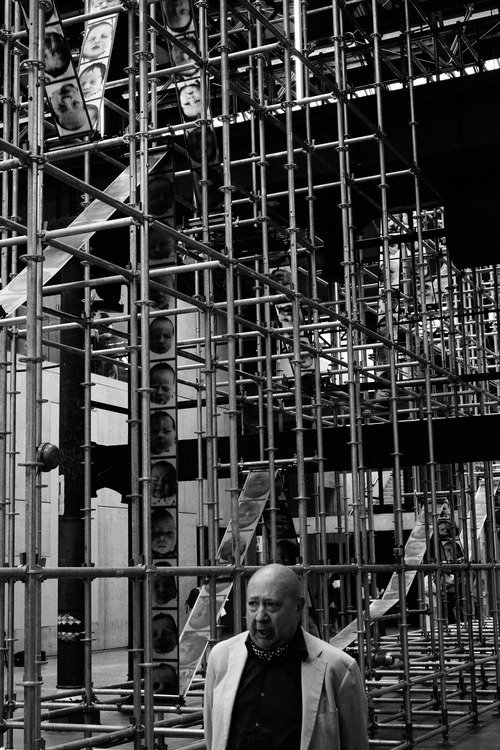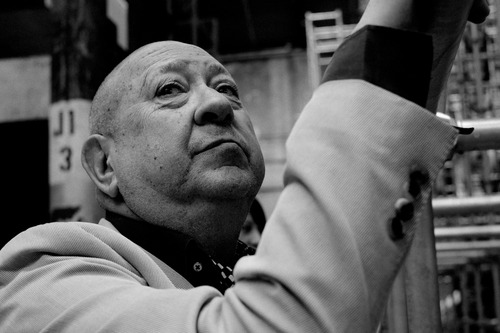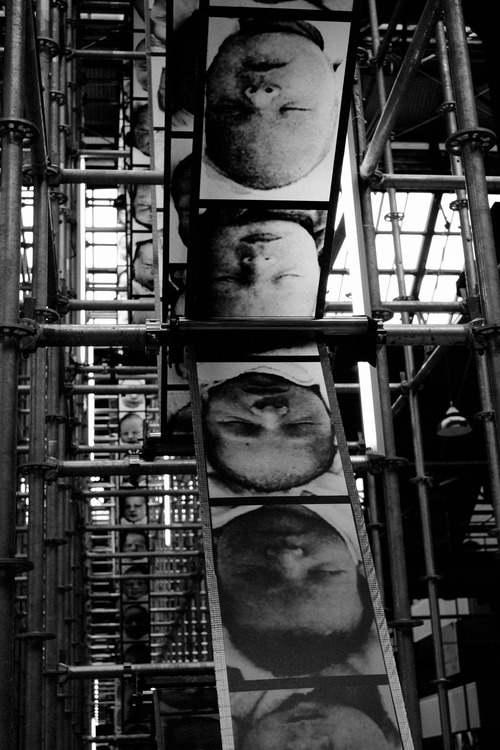
Christian Boltanski on Death, Sex, Gambling and God
Christian Boltanski’s art plays a shamanic role in our world. It attempts again and again to grasp the lost souls of humanity in order to preserve their value. We have the sense that if he could get any of these souls in a headlock, he would try to wrestle them into revealing something more about the fathomless. Hailed as one of the most influential artists of his generation, his work shares an omnipotence with its favorite subjects: Death and God.
Chance, a three-part artwork originally commissioned for the Venice Biennale of 2011, has recently come to life again at Carriageworks in Sydney, Australia, at an even greater scale. With images of newborn Polish babies spliced with images of newly dead Swiss, and digital installations of the numerical statistics of international births and deaths as they happen, this work, partly fed through an exaggerated printing press akin to a soul factory, is laced with his signature combination of mystery itself, and the longing to uncover whether life is happenstance or a mapped and meaningful destiny.
Chance makes the viewer feel uplifted and also small, and if we feel gratitude as well, it may be because after a lifetime of asking, the artist continues to question the invisible maker in order to pull us through the shamanic time warp, to be touched by an oeuvre that wants so badly to know.
I sat down with Boltanski under the colossal scaffolding of Chance, to talk to him about death, sex, gambling and God, and the altered state of being continually watched by a webcam.
—Caia Hagel
THE BELIEVER: One of the striking sensations I feel from Chance is the shock of how random and fleeting life actually is the way you show it to us scientifically — when it feels so important while living it.
CHRISTIAN BOLTANSKI: The science about life is very optimistic. Every second, four people in the world die, and six are born. This is optimistic. But life goes very fast and is only interested in living; life is only interested in being alive while moving at a pace toward its own end. Some time soon there will be another artist sitting here, and another writer. They won’t be the very same as you and I, but they will be similar. We are unique, but replaceable.
I like looking at the finger of God. Why it takes one and not another, why this one or that one, why now or why then. The finger of God is always on us. When you get older and you see your friends dying around you, you say “Why not me?” That machine is always there.
If there is a God, he doesn’t know us. It’s like if we walk in a forest and we kill some insects. He isn’t against us but he doesn’t know us. This machine is blind, it just takes what it can take, that’s all.
BLVR: I like it that you’ve entered this game of chance very literally in your wager with [art collector, gambler and Mona founder] David Walsh. How did it happen that you agreed to gamble your life with him?
CB: David is a very clever, incredible person. He wanted to buy a piece from me for his Mona museum. I thought he was so clever and so strange that I wished to play with him. So I sold him the right to have a video camera in my studio, where I live and work, that is filming day and night. He can zoom in and read my letters if he wants. What interests me is that he can see me getting older and older, he will have so many hours and hours of film, so many hours and hours of my life. It will be preserved.
I sold him this piece at a price but I decided to ask him to give me the money every month, until I die. In five years, he will have given me all the money that I asked for. So if I die in three years, he makes good business. But if I die in ten years, it’s a catastrophe for him. He told me that he has never lost in his life and that he is sure that I will die within five years. Who knows, perhaps he is going to win. I hope not, but somebody who says that they have never lost is something very strange. It’s like saying that you are stronger than God, stronger than chance.
I sometimes say hello to him into the camera but we’re not in communication. We don’t phone each other or send mail. It’s better, I think, not to be friends when we are playing with my life. But I know that he looks at me.

BLVR: Is this a bit like a contract with the devil?
CB: I have called him a devil but that is also because of the Tasmanian Devil. David is Tasmanian.
BLVR: Have you talked about what he will do with the footage?
CB: What I wish is that if there are thousands of hours, that they be made to go quick, speed them up to be faster than reality but with the possibility to stop the image. So sometimes you can catch me, sometimes you can’t.
BLVR: Then you will be as enigmatic as God.
CB: Perhaps. I’ve filled my whole life trying to preserve the memory of living, in the fight against dying. Perhaps the only thing I’ve done, since stopping death is impossible, is to show this fight. The fight itself does not satisfy us either. You go to my work, the mythology I created in Teshima, for example, where I’ve recorded the heartbeats of 80,000 people from different countries, some of them still alive, some of them not, and in this beautiful Japanese landscape, you stand with the heartbeats and feel only absence.
When I die and this footage of my life is there, preserved, you will see me but you will feel my absence. We cannot really capture life. But for me it’s important to know that these works exist.
BLVR: You are good at the invisible. Is it sort of similar when you say that you never make art about the Holocaust? Because we feel that it’s there, floating inside everything that you do, carrying the souls of those dead and the ghosts of our collective past.
CB: I believe that at the beginning of the life of every artist there is some kind of trauma. We have a problem and all of our life we try to speak about this problem. My trauma was historical. When I was three or four, all the friends of my parents were survivors of the Holocaust; they spoke a lot about that. My father was hiding during the war, it was something totally present when I was a boy. It is sure that it has made me.
BLVR: It might be more powerful to speak of this trauma invisibly.
CB: This is what is interesting about visual art. It is unfocused. Each person can see what they want to see in it. A table is a table, but an art table is a dog. Somebody can see a dog and somebody can see a table. It’s pretentious to say, but my art is like a little Zen story, a story with a question mark at the end. People can take from it what they need. If somebody says, “Your art is very funny,” I say, “You are totally right.” If somebody says, “Your art is very sad,” I say, “You are totally right.” In Japan they say, “Your art is very Japanese, you even look Japanese.Your great-grandfather was most surely a Japanese man.” And I say, “You are totally right.”
BLVR: I can see why every kind of person feels that they can appropriate you. Your subject is transpersonal; it impacts all of us.
CB: Well, to die is very strange. You can know a lot of things, be very intelligent, and know where to buy the best cake. But if I kill you, you are a piece of shit. It’s a question that has no answer.
I work a lot with Swiss dead people because the Swiss are rich, they are very clean—and yet they die. It is very strange because they have no reason to die, but they die. Why? Why do we die even when there is no reason to die?
In science we see progress. In art there is no progress. In art the questions have always been the same. From the beginning of time till now, we are always asking the same questions. There are very few. We are looking for God, we are asking why we die, we are contemplating sex and the beauty of nature. The only thing that changes is that, in each period of questioning, we speak with the language of our time.
BLVR: What language would you say your death questions speak in?
CB: I was lucky to be born during the time of minimalism. I think I can be colder because of this. In form I speak with minimalism but my feeling is sentimental—I am a sentimental minimalist.
BLVR: Are you interested in nature or sex?
CB: Well, nature doesn’t interest me so much but I would like to ask questions about sex.
BLVR: Why don’t you?
CB: I do. But every time I ask questions about sex, I always end up asking questions about death.
BLVR: Oh. That’s maybe a shame.
CB: Yes, you are totally right, it really is maybe a shame.

Christian Boltanski’s Chance is on at Carriageworks, Sydney, through March 23rd, 2014.
Mona (Museum of Old and New Art)
Believer contributor Caia Hagel interviews artists, celebrities, demi-gods and monsters, in search ofthe sublime. Her personality profiles, travelogues, art talks and fictions appear here and there in magazines, on social media and TV networks internationally.




